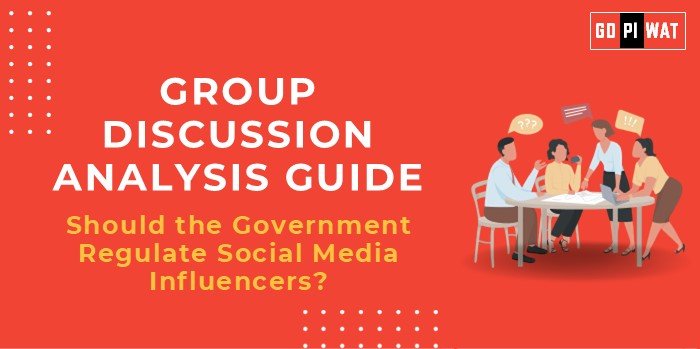📋 Group Discussion Analysis Guide: Should the Government Regulate Social Media Influencers?
🌐 Introduction to Social Media Influencer Regulation
Context Setting: Social media influencers have become pivotal in shaping consumer behavior and public opinion. Their vast reach and persuasive power have sparked debates on the necessity of governmental regulation to ensure ethical practices and protect consumers.
Background: Influencers, individuals with substantial online followings, often promote products, services, and ideas. The lack of standardized oversight has led to instances of misinformation, undisclosed advertising, and ethical concerns, prompting discussions on implementing regulatory frameworks.
📊 Quick Facts and Key Statistics
• 🤝 Consumer Trust Issues: Approximately 49% of consumers have lost trust in influencers due to instances of misconduct, affecting brand reputations.
• ⚖️ Regulatory Landscape: Countries like the United States, through the Federal Trade Commission (FTC), have established guidelines for influencer advertising, highlighting global inconsistencies in regulation.
• 👩💻 Youth Influence: Studies indicate that 70% of Generation Z trust influencers more than traditional celebrities, underscoring the significant impact on younger demographics.
🏛️ Stakeholders and Their Roles
- Government Agencies: Potential regulators to establish guidelines ensuring transparency and consumer protection.
- Social Media Platforms: Responsible for enforcing content policies, identifying sponsored content, and mitigating misinformation.
- Influencers and Brands: Obligated to maintain transparency in endorsements and uphold ethical standards to preserve audience trust.
- Consumers: Need to exercise critical judgment and seek digital literacy to navigate influencer content effectively.
🏆 Achievements and ⚠️ Challenges
✨ Achievements
- 💰 Economic Impact: Influencer marketing has created substantial revenue streams and employment opportunities within the digital economy.
- 💬 Authenticity and Engagement: Offers brands personalized marketing strategies that resonate with target audiences, enhancing consumer engagement.
- 🌟 Innovation and Trends: Influencers often spearhead trends, contributing to the dynamic nature of social media and consumer culture.
⚠️ Challenges
- 📝 Transparency Issues: Lack of clear disclosure on paid partnerships can lead to deceptive advertising practices.
- ❌ Ethical Concerns: Promotion of harmful products or misinformation, particularly in health and finance sectors, poses risks to consumers.
🌍 Global Comparisons
United States: The FTC enforces guidelines requiring influencers to disclose sponsored content, aiming to protect consumers from deceptive practices.
United Kingdom: The Advertising Standards Authority (ASA) mandates clear labeling of advertisements by influencers to ensure transparency.
Case Studies:
- India: In 2022, the Advertising Standards Council of India (ASCI) introduced guidelines for influencer advertising, emphasizing disclosure and transparency.
- United States: The FTC has fined influencers for nondisclosure of paid partnerships, reinforcing the importance of transparency in influencer marketing.
💬 Structured Arguments for Discussion
Supporting Stance: “Implementing government regulations for social media influencers is essential to ensure transparency and protect consumers from misleading content.”
Opposing Stance: “Excessive regulation may stifle creativity and authenticity in influencer marketing, which are key elements that attract and engage audiences.”
Balanced Perspective: “While regulation is necessary to safeguard consumers, policies should be designed to maintain the creative freedom and authenticity that define influencer marketing.”
🗣️ Effective Discussion Approaches
- Opening Approaches:
- 📊 Statistical Impact: “With the influencer marketing industry valued at over $21 billion, the lack of standardized regulations raises concerns about consumer protection and ethical advertising.”
- ⚖️ Contrast Approach: “Despite the significant economic contributions of influencers, the absence of regulatory oversight has led to instances of misinformation and ethical breaches.”
- Counter-Argument Handling:
- 🛑 Acknowledge Concerns: Recognize the potential for overregulation to hinder creativity.
- 💡 Present Solutions: Suggest implementing flexible guidelines that promote transparency without imposing rigid constraints.
- 📚 Support with Data: Cite examples where balanced regulations have been successfully implemented, such as the FTC’s guidelines in the U.S.
- 📈 Show Progress Trajectory: Discuss how evolving regulations can adapt to the dynamic nature of social media and influencer marketing.
🔍 Strategic Analysis of Strengths and Weaknesses
- Strengths:
- 🌍 Wide Reach: Ability to connect with diverse and large audiences.
- 💸 Economic Contribution: Significant role in digital marketing and advertising revenues.
- 💬 Authentic Engagement: Potential to build genuine connections with followers.
- Weaknesses:
- 🔍 Lack of Transparency: Instances of undisclosed sponsored content.
- ⚠️ Ethical Issues: Potential for spreading misinformation or promoting harmful products.
- Opportunities:
- 🤝 Self-Regulation: Development of industry standards and best practices.
- 🤝 Collaborations: Partnerships with regulatory bodies to create balanced guidelines.
- 📚 Education: Initiatives to enhance digital literacy among consumers.
- Threats:
- 💔 Loss of Trust: Erosion of consumer confidence due to unethical practices.
- ⚖️ Legal Repercussions: Potential for lawsuits and fines resulting from non-compliance.
- 📉 Market Saturation: Overcrowding leading to diminished influence and effectiveness.
📚 Connecting with B-School Applications
Real-World Applications: Understanding the regulatory landscape of influencer marketing is crucial for roles in digital marketing, brand management, and consumer protection.
Sample Interview Questions:
- “How can regulatory frameworks balance consumer protection with the creative freedom of influencers?”
- “Discuss the ethical responsibilities of social media influencers in the context of marketing and advertising.”
Insights for B-School Students:
- ⚖️ Ethical Marketing: Emphasize the importance of transparency and honesty in marketing practices.
- 📖 Regulatory Awareness: Stay informed about evolving laws and guidelines affecting digital marketing.
- 📊 Consumer Behavior: Understand the impact of influencer marketing on consumer decisions and brand perception.


